Climate Change Implications for Water Availability: A Case Study of Barcelona City
Abstract
1. Introduction
2. Materials and Methods
2.1. Hydrological Model Background: Description and Setup
2.2. Model Calibration, Validation, and Sensitivity Analysis
2.3. Framework for Assessing Future Water Resources Allocation
3. A Case Study for Barcelona City
3.1. The Study Area
- La Baells: Llobregat river basin divides into four sub-basins. Those contained in Guardiola de Berguedà zone include aquifers 112 and 115, with an area of low permeability. This sub-basin catches the flow from the upstream sub-basins and adds its contribution.
- La Llosa del Cavall: Four different sub-basins constitute this Llobregat river basin. La Coma i La Pedra y La Llosa del Cavall represent a part of aquifer 116, with two additional sub-basins of low permeability downstream.
- Sant Ponç: Two sub-basins define the basin part of the Llobregat river. In this case, there is no aquifer over the area.
- Sau: This Ter river basin is divided into six different areas. Those located within the region up to the Ripoll gauge station correspond to the upper aquifers 110 and 115, which represent 75% of the total contribution reaching the Sau reservoir. Sub-basins’ simulation was with the same properties but with different precipitation and temperature data.
- Susqueda: It considers one sub-basin of Ter river catchment. Besides, it employs a setting of aquifer 203 parameters for month-by-month water contributions.
3.2. Data
4. Results
4.1. Evapotranspiration Calibration
4.2. Calibration and Validation of Hydrological Parameters
4.3. Simulations under Future Rainfall Conditions
5. Discussion
6. Conclusions
Author Contributions
Funding
Acknowledgments
Conflicts of Interest
References
- Chen, L.; Guo, S. Copulas and its Application in Hydrology and Water Resources; Springer: Singapore, 2019; ISBN 9789811305733. [Google Scholar]
- Grillakis, M.G. Increase in severe and extreme soil moisture droughts for Europe under climate change. Sci. Total Environ. 2019, 660, 1245–1255. [Google Scholar] [CrossRef]
- Tian, W.; Liu, X.; Liu, C.; Bai, P. Investigation and simulations of changes in the relationship of precipitation-runoff in drought years. J. Hydrol. 2018, 565, 95–105. [Google Scholar] [CrossRef]
- Hao, Z.; Hao, F.; Singh, V.P.; Sun, A.Y.; Xia, Y. Probabilistic prediction of hydrologic drought using a conditional probability approach based on the meta-Gaussian model. J. Hydrol. 2016, 542, 772–780. [Google Scholar] [CrossRef]
- Singh, S.; Sharma, V.K. Urban Droughts in India: Case Study of Delhi; Springer: Singapore, 2019; ISBN 9789811089466. [Google Scholar]
- Roudier, P.; Andersson, J.C.M.; Donnelly, C.; Feyen, L.; Greuell, W.; Ludwig, F. Projections of future floods and hydrological droughts in Europe under a +2°C global warming. Clim. Change 2016, 135, 341–355. [Google Scholar] [CrossRef]
- Koutroulis, A.G.; Papadimitriou, L.V.; Grillakis, M.G.; Tsanis, I.K.; Wyser, K.; Betts, R.A. Freshwater vulnerability under high end climate change. A pan-European assessment. Sci. Total Environ. 2018, 613–614, 271–286. [Google Scholar] [CrossRef] [PubMed]
- Iglesias, A.; de Garrote, L.; Cancelliere, A.; Cubillo, F.; Wilhite, D. Coping with Drought Risk in Agriculture and Water Supply Systems Drought Management and Policy Development in the Mediterranean; Springer: Dordrecht, Netherlands, 2009; ISBN 9781402090448. [Google Scholar]
- Anand, J.; Gosain, A.K.; Khosa, R. Optimisation of multipurpose reservoir operation by coupling soil and water assessment tool (SWAT) and genetic algorithm for optimal operating policy (case study: Ganga River Basin). Sustainability 2018, 10, 1660. [Google Scholar] [CrossRef]
- Barcelona Regional; Ajuntament de Barcelona Cicle de L’Aigua - Estudi dels Impactes del Camvi Climàtic a Barcelona. Available online: http://www3.amb.cat/repositori/PSAMB/Canvi_clima.pdf (accessed on 19 November 2019).
- Generalitat de Catalunya; Agència Catalana de L’Aigua; Molist, J. Pla especial d’actuació en situació d’alerta i eventual sequera. Informe de sostenabilitat ambiental. Available online: http://aca.gencat.cat/web/.content/30_Plans_i_programes/30_Pla_sequera/bloc1/04_pes_Isa_ca.pdf (accessed on 7 November 2019).
- Martin-Ortega, J.; González-Eguino, M.; Markandya, A. The costs of drought: The 2007/2008 case of Barcelona. Water Policy 2012, 14, 539–560. [Google Scholar] [CrossRef]
- Coll, J.R.; Aguilar, E.; Prohom, M.; Sigró, J. Variabilidad y tendencias a largo plazo de las sequías en Barcelona (1787-2014). Cuad. Investig. Geogr. 2016, 42, 29–48. [Google Scholar] [CrossRef]
- Pascual, D.; Pla, E.; Lopez-Bustins, J.A.; Retana, J.; Terradas, J. Impacts du changement climatique sur les ressources en eau dans le bassin méditerranéen: Une étude de cas en Catalogne, Espagne. Hydrol. Sci. J. 2015, 60, 2132–2147. [Google Scholar] [CrossRef]
- Gallart, F.; Delgado, J.; Beatson, S.J.V.; Posner, H.; Llorens, P.; Marcé, R. Analysing the effect of global change on the historical trends of water resources in the headwaters of the Llobregat and Ter river basins (Catalonia, Spain). Phys. Chem. Earth 2011, 36, 655–661. [Google Scholar] [CrossRef]
- Barcelona Regional. Ajuntament de Barcelona Estratègia Delta del Llobregat. Available online: https://ajuntament.barcelona.cat/economiatreball/sites/default/files/documents/MemoriaESTRATEGIADELTA_A4_completa.pdf (accessed on 18 September 2019).
- Agència Catalana de l’Aigua Aigua i Canvi Cimàtic. Diagnosi dels Impactes Previstos a Catalunya. Available online: http://www.gencat.cat/mediamb/publicacions/monografies/aigua_canvi_climatic.pdf (accessed on 25 September 2019).
- Seibert, J.; Vis, M.J.P. Teaching hydrological modeling with a user-friendly catchment-runoff-model software package. Hydrol. Earth Syst. Sci. 2012, 16, 3315–3325. [Google Scholar] [CrossRef]
- Versini, P.A.; Pouget, L.; McEnnis, S.; Custodio, E.; Escaler, I. Climate change impact on water resources availability: Case study of the Llobregat River basin (Spain). Hydrol. Sci. J. 2016, 61, 2496–2508. [Google Scholar] [CrossRef]
- Velasco, M.; Versini, P.A.; Cabello, A.; Barrera-Escoda, A. Assessment of flash floods taking into account climate change scenarios in the Llobregat River basin. Nat. Hazards Earth Syst. Sci. 2013, 13, 3145–3156. [Google Scholar] [CrossRef]
- Andreu, J.; Solera, A. Methodology for the analysis of drought mitigation measures in water resources systems. Drought Manag. Plan. Water Resour. 2006, 133–168. [Google Scholar]
- Céspedes, R.; Lacorte, S.; Ginebreda, A.; Barceló, D. Chemical monitoring and occurrence of alkylphenols, alkylphenol ethoxylates, alcohol ethoxylates, phthalates and benzothiazoles in sewage treatment plants and receiving waters along the ter River basin (Catalonia, N.E. Spain). Anal. Bioanal. Chem. 2006, 385, 992–1000. [Google Scholar] [CrossRef]
- Honey-Rosés, J.; Acuña, V.; Bardina, M.; Brozović, N.; Marcé, R.; Munné, A.; Sabater, S.; Termes, M.; Valero, F.; Vega, À.; et al. Examining the demand for ecosystem services: The value of stream restoration for drinking water treatment managers in the Llobregat river, Spain. Ecol. Econ. 2013, 90, 196–205. [Google Scholar] [CrossRef]
- Pouget, L.; Escaler, I.; Guiu, R.; Mc Ennis, S.; Versini, P.A. Global Change adaptation in water resources management: The Water Change project. Sci. Total Environ. 2012, 440, 186–193. [Google Scholar] [CrossRef]
- Climate Research Foundation (FIC). Downscaled climate model outputs of the RESCCUE project. Available online: https://www.ficlima.org/intercambio/indexed/RESCCUE/ (accessed on 19 November 2019).
- Ribalaygua, J.; Torres, L.; Portoles, J.; Monjo, R.; Gaitan, E.; Pino, M. Description and validation of a two-step analogue/regression downscaling method. Theor. Appl. Climatol. 2013, 114, 253–269. [Google Scholar] [CrossRef]
- Bi, D.; Dix, M.; Marsland, S.J.; O’Farrell, S.; Rashid, H.; Uotila, P.; Hirst, A.C.; Kowalczyk, E.; Golebiewski, M.; Sullivan, A.; et al. The ACCESS coupled model: Description, control climate and evaluation. Aust. Meteorol. Ocean. J 2013, 63, 41–64. [Google Scholar] [CrossRef]
- Xiao-Ge, X.; Tong-Wen, W.; Jie, Z. Introduction of CMIP5 Experiments Carried out with the Climate System Models of Beijing Climate Center. Adv. Clim. Chang. Res. 2013, 4, 41–49. [Google Scholar] [CrossRef]
- Chylek, P.; Li, J.; Dubey, M.K.; Wang, M.; Lesins, G. Observed and model simulated 20th century Arctic temperature variability: Canadian Earth System Model CanESM2. Atmos. Chem. Phys. Discuss. 2011, 11, 22893–22907. [Google Scholar] [CrossRef]
- Voldoire, A.; Sanchez-Gomez, E.; y Mélia, D.; Decharme, B.; Cassou, C.; Sénési, S.; Valcke, S.; Beau, I.; Alias, A.; Chevallier, M.; et al. The CNRM-CM5.1 global climate model: Description and basic evaluation. Clim. Dyn. 2013, 40, 2091–2121. [Google Scholar] [CrossRef]
- Dunne, J. GFDL’s ESM2 Global Coupled Climate-Carbon Earth System Models. Part I: Physical Formulation and Baseline Simulation Characteristics. J. Clim. 2012, 25, 6646–6665. [Google Scholar] [CrossRef]
- Watanabe, S.; Hajima, T.; Sudo, K.; Nagashima, T.; Takemura, T.; Okajima, H.; Nozawa, T.; Kawase, H.; Abe, M.; Yokohata, T.; et al. MIROC-ESM 2010: Model description and basic results of CMIP5-20c3m experiments. Geosci. Model Dev. 2011, 4, 845. [Google Scholar] [CrossRef]
- Marsland, S.J.; Haak, H.; Jungclaus, J.H.; Latif, M.; Röske, F. The Max-Planck-Institute global ocean/sea ice model with orthogonal curvilinear coordinates. Ocean Model. 2003, 5, 91–127. [Google Scholar] [CrossRef]
- Yukimoto, S.; Yoshimura, H.; Hosaka, M.; Sakami, T.; Tsujino, H.; Hirabara, M.; Tanaka, T.; Deushi, M.; Obata, A.; Nakano, H.; et al. Meteorological Research Institute-Earth System Model Version 1 (MRI-ESM1)—Model Description. Tech. Reports Meteorol. Res. Inst. 2011, 64, 1–96. [Google Scholar]
- Bentsen, M.; Bethke, I.; Debernard, J.B.; Iversen, T.; Kirkevåg, A.; Seland, Ø.; Drange, H.; Roelandt, C.; Seierstad, I.A.; Hoose, C.; et al. The Norwegian Earth System Model, NorESM1-M – Part 1: Description and basic evaluation of the physical climate. Geosci. Model Dev. 2013, 6, 687–720. [Google Scholar] [CrossRef]
- Iversen, T.; Bentsen, M.; Bethke, I.; Debernard, J.; Kirkevåg, A.; Seland, Ø.; Drange, H.; Kristjansson, J.; Medhaug, I.; Sand, M.; et al. The Norwegian Earth System Model, NorESM1-M - Part 2: Climate response and scenario projections. Geosci. Model Dev. 2013, 6, 389. [Google Scholar] [CrossRef]
- Agència catalana de l’aigua Pla especial d’actuació en situació d’alerta i eventual sequera Districte de conca fluvial de Catalunya. 2009.
- Cetaqua Identification of impacts and definition of adaptation measures. Available online: https://climate-adapt.eea.europa.eu/metadata/projects/medium-and-long-term-water-resources-modelling-as-a-tool-for-planning-and-global-change-adaptation-application-to-the-llobregat-basin (accessed on 12 October 2019).
- Duran, X.; Picó, M.J.; Reales, L. El Cambio Climático en cataluña. Resumen ejecutivo del Tercer informe sobre el cambio climático en Cataluña; Institut d’Estudis Catalans y Generalitat de Catalunya: Barcelona, Spain, 2017; ISBN 9788439396208. [Google Scholar]
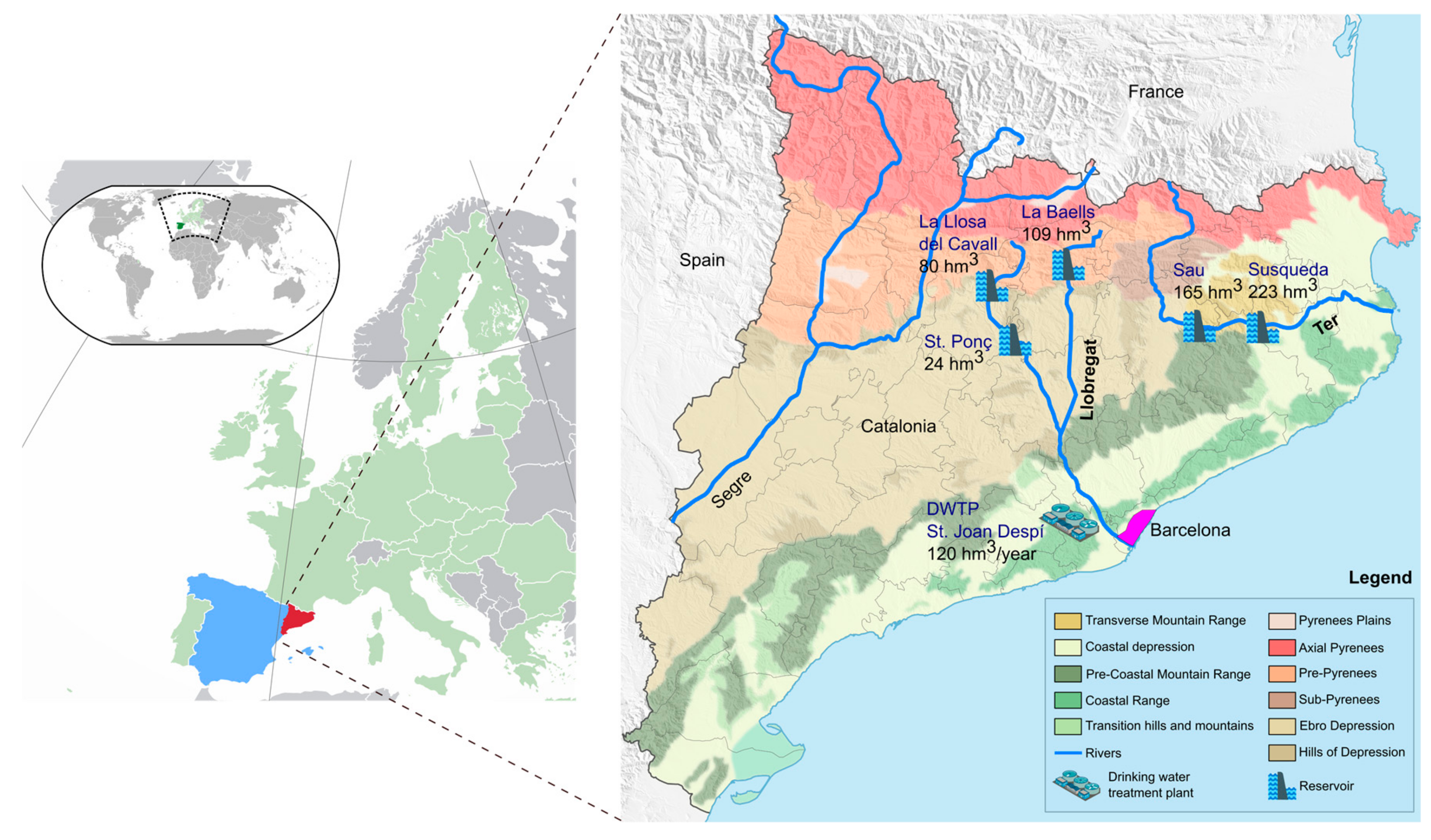

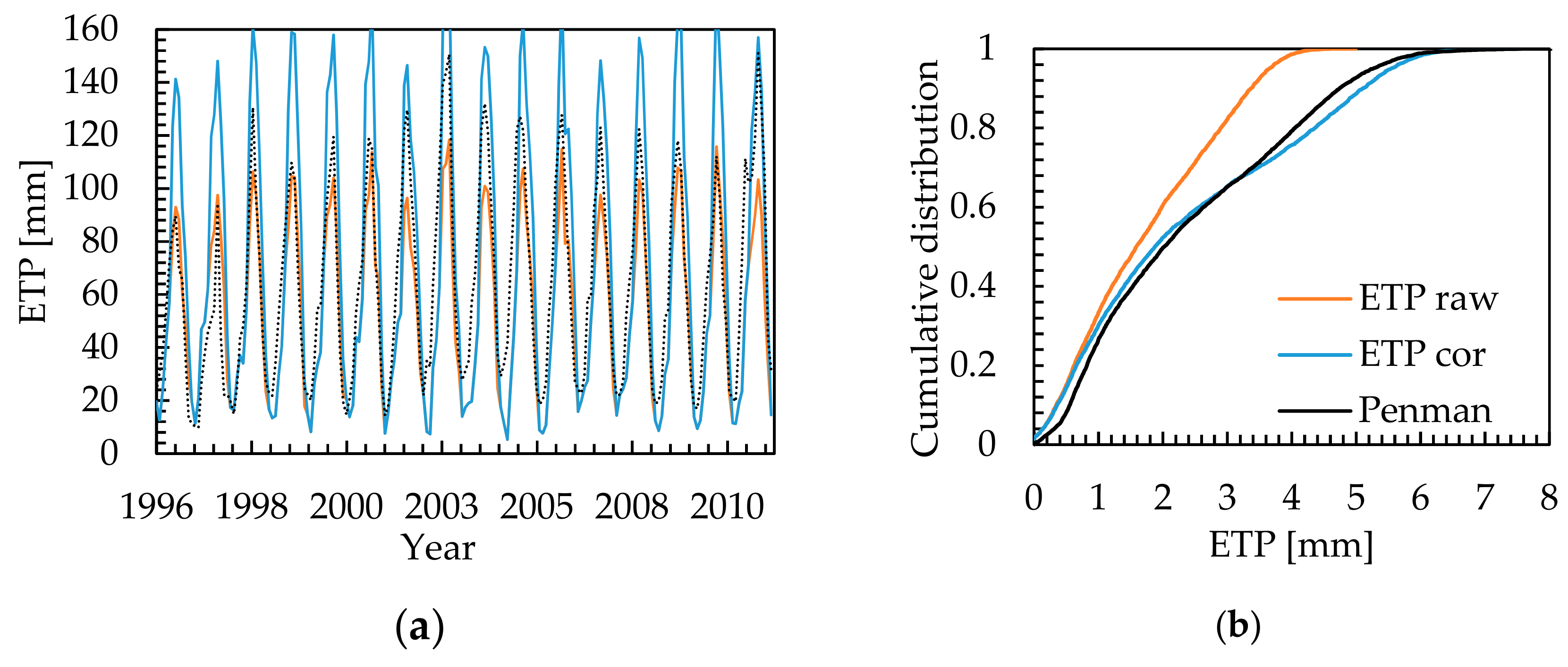
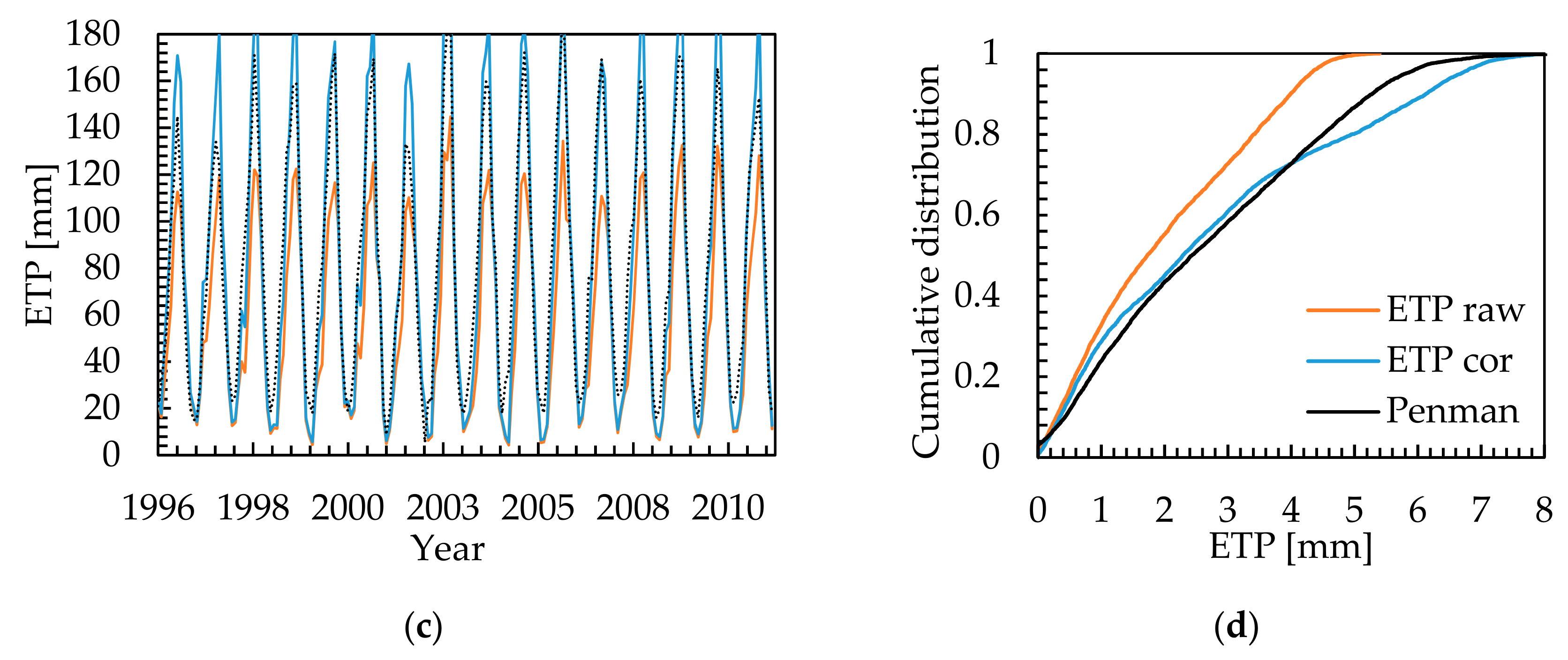
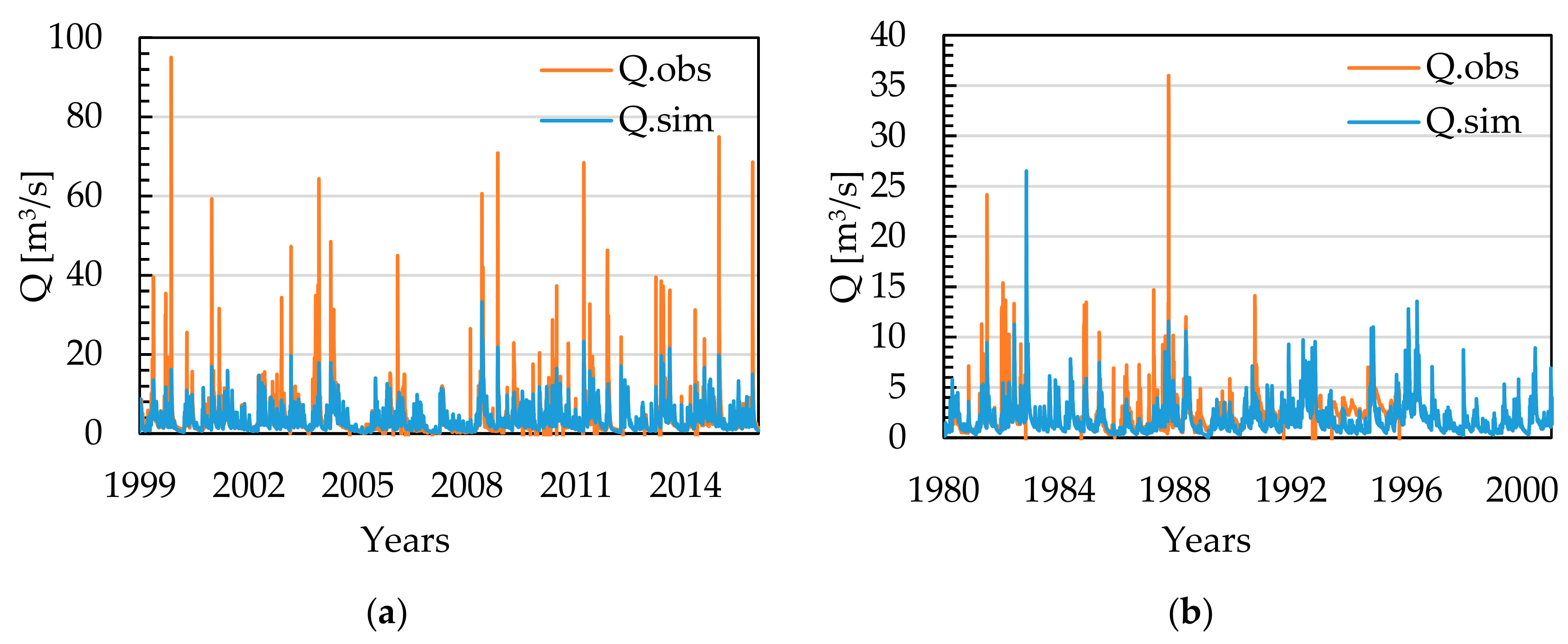
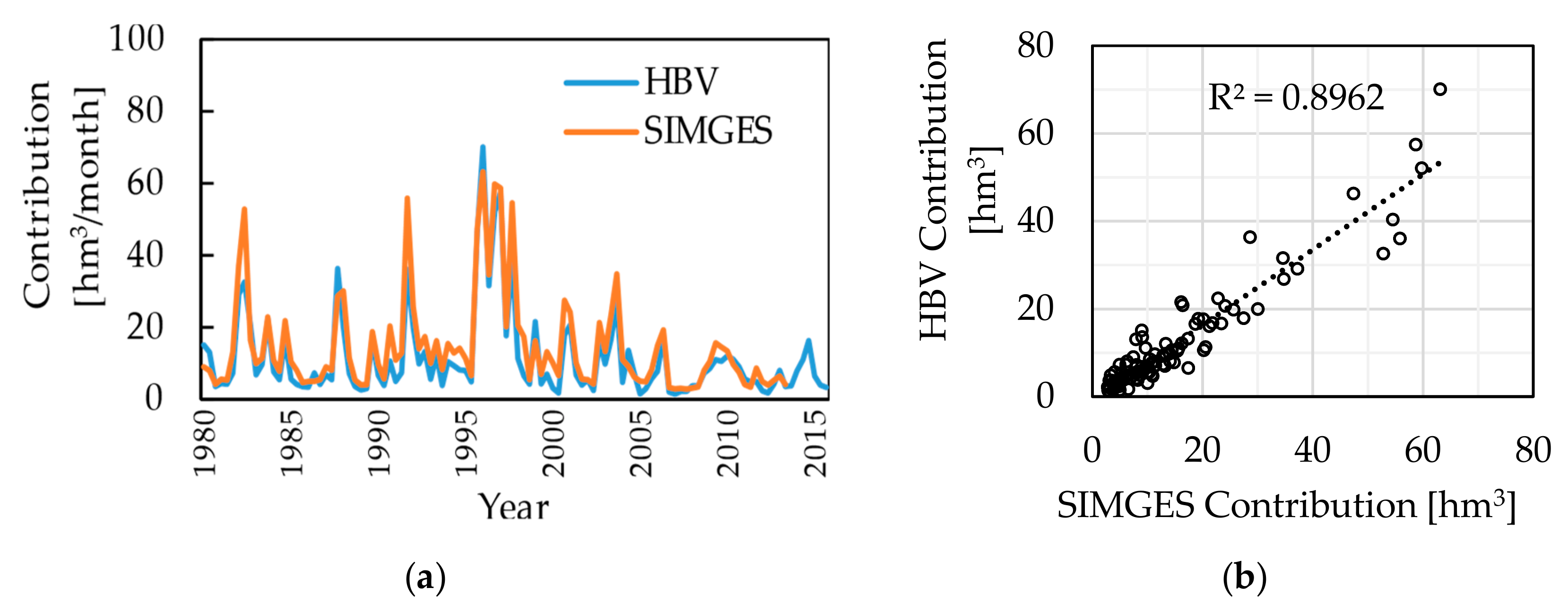


| HBV Model Parameter | Description {Unit} |
|---|---|
| β | A shape coefficient that determines the precipitation contribution to the runoff |
| FC | Field capacity {mm} |
| LP | Limit above Actual Evapotranspiration (AET) reaches ETP |
| K1 | Recession coefficient |
| K2 | Recession coefficient |
| UZL | Threshold parameter {mm} |
| Perc | Percolation ratio |
| Institution | CMIP5 Model | Source | Resolution (Lon × Lat) |
|---|---|---|---|
| Commonwealth Scientific and Industrial Research Organisation (CSIRO), Bureau of Meteorology (BOM) | ACCESS1-0 | [27] | 1.87°×1.25° |
| Beijing Climate Center (BCC) | BCC-CSM1-1 | [28] | 2.8°×2.8° |
| Canadian Centre for Climate Modelling and Analysis (CC-CMA) | CanESM2 | [29] | 2.8°×2.8° |
| National Center for Meteorological Research, Météo-France and CNRS laboratory (CNRM-CERFACS) | CNRM-CM5 | [30] | 1.4°×1.4° |
| Geophysical Fluid Dynamics Laboratory (GFDL) | GFDL-ESM2M | [31] | 2°×2.5° |
| Japan Agency for Marine-Earth Science and Technology (JAMSTEC), Atmosphere and Ocean Research Institute, the University of Tokyo (AORI), Japan National Institute for Environmental Studies (NIES) | MIROC-ESM-CHEM | [32] | 1.4°×1.4° |
| Max Planck Institute for Meteorology (MPI-M) | MPI-ESM-MR | [33] | 1.8°×1.8° |
| Meteorological Research Institute, Japan Meteorological Agency (MRI) | MRI-CGCM3 | [34] | 1.2°×1.2° |
| Norwegian Climate Centre (NCC) | NorESM1-M | [35,36] | 2.5°×1.9° |
| Nash-Coefficient | Winter | Spring | Summer | Autumn | Total |
|---|---|---|---|---|---|
| La Baells | 0.85 | 0.67 | 0.51 | 0.89 | 0.79 |
| La Llosa del Cavall | 0.72 | 0.60 | 0.44 | 0.22 | 0.49 |
| Sant Ponç | 0.60 | 0.10 | 0.10 | 0.62 | 0.33 |
| Llobregat’s Contribution | 0.85 | 0.64 | 0.55 | 0.87 | 0.79 |
| Sau | 0.82 | 0.81 | 0.75 | 0.69 | 0.77 |
| Susqueda | 0.59 | 0.31 | 0.32 | 0.41 | 0.42 |
| Ter’s Contribution | 0.85 | 0.83 | 0.77 | 0.73 | 0.80 |
| Study | Mean Expected Reduction by 2050 | Mean Expected Reduction by 2100 |
|---|---|---|
| Climate change impacts study in Barcelona—water cycle [10] | 12% | No Data |
| RESCCUE Project | 9% | 11% |
| Water and climate change. Diagnosis of the impacts predicted in Catalonia [17,37] | 7%–15% according to diverse scenarios | No Data |
© 2020 by the authors. Licensee MDPI, Basel, Switzerland. This article is an open access article distributed under the terms and conditions of the Creative Commons Attribution (CC BY) license (http://creativecommons.org/licenses/by/4.0/).
Share and Cite
Forero-Ortiz, E.; Martínez-Gomariz, E.; Monjo, R. Climate Change Implications for Water Availability: A Case Study of Barcelona City. Sustainability 2020, 12, 1779. https://doi.org/10.3390/su12051779
Forero-Ortiz E, Martínez-Gomariz E, Monjo R. Climate Change Implications for Water Availability: A Case Study of Barcelona City. Sustainability. 2020; 12(5):1779. https://doi.org/10.3390/su12051779
Chicago/Turabian StyleForero-Ortiz, Edwar, Eduardo Martínez-Gomariz, and Robert Monjo. 2020. "Climate Change Implications for Water Availability: A Case Study of Barcelona City" Sustainability 12, no. 5: 1779. https://doi.org/10.3390/su12051779
APA StyleForero-Ortiz, E., Martínez-Gomariz, E., & Monjo, R. (2020). Climate Change Implications for Water Availability: A Case Study of Barcelona City. Sustainability, 12(5), 1779. https://doi.org/10.3390/su12051779






